John Constantine first appeared in Saga of the Swamp Thing #25 by Alan Moore, Steve Bissette, & John Totleben in 1984. A snarky, cynical, embittered occult detective with a penchant for cigarettes, Constantine was inspired by the rock star Sting. Originally conceived as a one-off, he proved to be a popular supporting character in Swampy’s book, and four years after his debut, his solo title Hellblazer debuted, by Jamie Delano & John Ridgway. One of the earliest titles in DC’s Vertigo imprint, Hellblazer was both the longest-running Vertigo title and also one that survived that imprint’s shutting down.
While the implied notion of Sting playing Constantine in a live-action adaptation never happened—the character wasn’t part of either of the Swamp Thing movies or spinoff TV show—the character did eventually make it to the screen in 2005.
Development of the film started in the late 1990s when Lauren Shuler Donner—also a producer of the X-Men films—acquired the rights. The film went through a few directors—including Tarsem Singh, who actually sued Warner Bros. after he quit—and initially Nicolas Cage was attached as the star before they settled on Keanu Reeves.
While Neil Gaiman’s The Sandman may be the rock star of the Vertigo line, burning bright and eventually flaming out, Hellblazer was always more the great musician who’s there every week at your favorite club like clockwork. Constantine became a very popular character, but in a weird kind of low-key way. He didn’t dominate the market the way characters like Spider-Man and Wolverine and Batman and Lobo have at various points, but he’s been a consistent and well-liked presence. Constantine was doing the snarky asshole long before it was popular, and he’s still one of the finest examples of it. The influence of the character can be seen all over the popular culture of the past thirty years, most aggressively in the form of Castiel on Supernatural, who was pretty much modeled on Constantine (by actor Misha Collins’s own admission, not that it wasn’t blindingly obvious from the microsecond Castiel first appeared on screen back in the show’s fourth season).
The list of Constantine’s chroniclers in comic book form is a who’s who of comics writers from the British Isles: Moore, Delano, Garth Ennis, Paul Jenkins, Warren Ellis, Denise Mina, Peter Milligan, Andy Diggle. In fact, up until recently (when it’s been mostly Canadians and Americans), Hellblazer and its spinoffs have all been written entirely by folks from the UK and its environs, with the notable exception of Brian Azzarello.
Which is why there was a certain amount of consternation when the movie rights were purchased and the character was made into an American. Many viewed this as akin to making the lead in Doctor Who be anything other than a Brit.
Still, the movie went ahead, with first-time feature-film director Francis Lawrence at the helm. Lawrence would go on to direct Will Smith’s version of I Am Legend as well as all the Hunger Games sequels. The action was moved to Los Angeles, with Reeves—whom no one will ever mistake for Sting—in the title role. Following unpleasant experiences with the adaptations of The League of Extraordinary Gentlemen and From Hell, Moore not only refused to be credited as the creator of the character in the movie, he also wouldn’t accept any money for the film. (He would do this again for the film versions of V for Vendetta and Watchmen.)
The movie was entitled Constantine rather than Hellblazer, as the comic book’s title was deemed too similar to Hellraiser, the Clive Barker movie series. (Amusingly, the comic was originally going to be called Hellraiser, but they changed it for similar Barker-induced reasons.) Nine years after it was released to a lukewarm reception, NBC put out a Constantine TV series starring Matt Ryan, an actual Brit (Welsh, in truth), who looked and acted very much like his comic book counterpart. The show only lasted one season, but the character has lived on in the “Arrowverse” on the CW, with appearances in Arrow and Legends of Tomorrow (in fact, Ryan is joining the latter for its fourth season as an opening-credits regular). Ryan has also voiced Constantine for various animated projects, including further Constantine animated tales and Justice League Dark.
This movie, however, was never picked up on. While it did decently at the box office, and Lawrence was talking about a sequel in an interview in 2011, at this point, Ryan’s Constantine is the set screen version, with Reeves’s consigned to the same one-off dustbin that Henry Cavill’s Superman condemned Brandon Routh to and Charlie Cox’s Daredevil consigned Ben Affleck to.
“God’s a kid with an ant farm, lady, he’s not planning anything”
Constantine
Written by Kevin Brodbin and Frank Cappello
Directed by Francis Lawrence
Produced by Lauren Shuler Donner and Benjamin Melniker and Michael E. Uslan and Erwin Stoff and Lorenzo di Bonaventura and Akiva Goldsman
Original release date: February 18, 2005
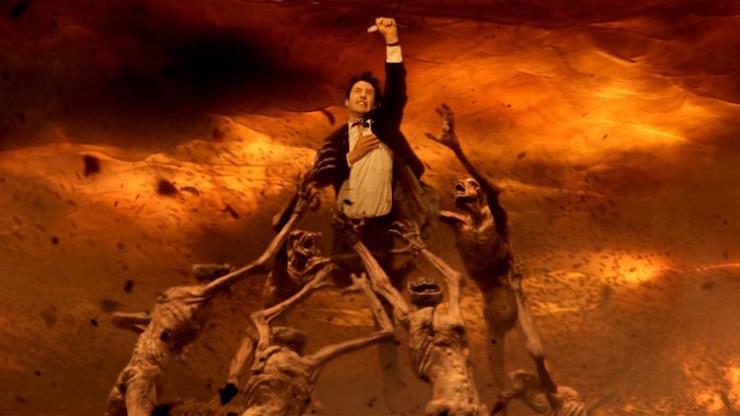
A man in Mexico stumbles across an ornate blade wrapped in a Nazi flag. He runs away with the blade—which is the Spear of Destiny, the blade used to stab Jesus Christ on the cross. When he’s hit by a truck, he’s unaffected.
Father Hennessy, who can speak to the dead, summons John Constantine to a small apartment, where a girl has been possessed. Hennessy’s attempt at an exorcism fails, but Constantine is able to get rid of the demon by trapping it in a mirror and shattering the mirror. However, demons aren’t supposed to appear on Earth, only their halfbreed spawn can do so to influence humanity. God and Lucifer made a deal to let humanity find its own path without overt interference from the angels or demons, only nudges and suggestions.
A woman named Isabel Dodson commits suicide while in a psychiatric hospital. Her twin, Detective Angela Dodson, is sure Isabel didn’t really commit suicide, because both Dodsons are devout Catholics (in her first scene, she’s in confession). She tries and fails to convince the parish priest to let her have a Catholic funeral, but the bishop insists that suicide is a mortal sin and she’s out of luck.
Constantine, a chain-smoker who has been diagnosed with terminal lung cancer, goes to the angel Gabriel. He has spent his life sending halfbreed demons who break the rules back to hell, and he feels that he deserves to go to heaven. Gabriel reminds him that he tried to commit suicide when he was fifteen, because he couldn’t handle being able to see who among humanity is truly a halfbreed angel or demon. That’s a mortal sin, and he can send all the demons to hell he wants, it won’t be enough to get him into heaven.
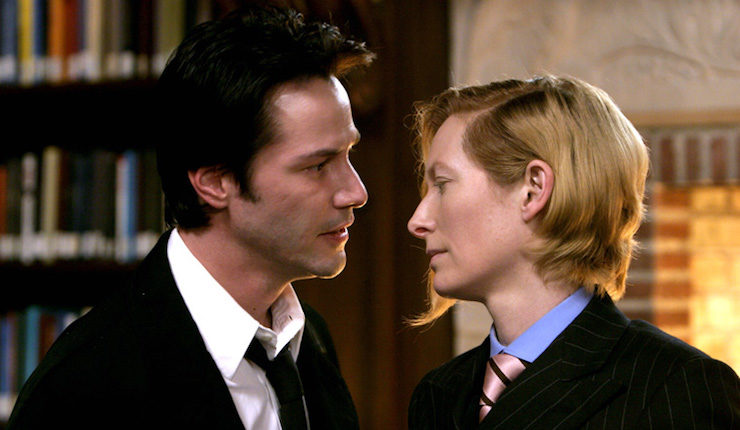
He’s also concerned that a demon tried to break through, and another one attacked him on the street, but Gabriel doesn’t believe him, assuming it’s a trick to get the angel to extend his life.
Angela goes to Constantine, since he’s known as an occult expert, and Isabel spent the last few weeks of her life talking about demons and things. The first thing Constantine does is confirm that Isabel is, in fact, in hell.
They go to Isabel’s hospital room. Constantine tries to get Angela to think of a way Isabel might have left them a clue as to why she killed herself—and she finally remembers how when they were kids they would write notes with their fingers on windows that could be seen when you breathe on them.
She breathes on a window and sees a Bible verse citation—except it’s from 1 Corinthians 17, and the First Epistle of the Corinthians has only sixteen chapters. However, Constantine explains that the Satanic Bible has more chapters in 1 Corinthians. According to Constantine’s supplier Beeman, that chapter describes Satan’s son Mammon attempting to take over the Earth as his kingdom. Unfortunately, Beeman is killed by demons shortly after revealing this. In addition, Hennessy is driven to suicide by Balthazar, a halfbreed demon who has crossed paths with Constantine.
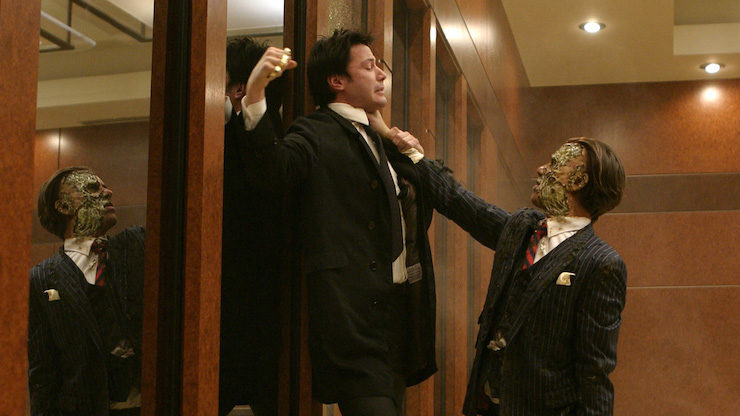
Isabel was a psychic and clairvoyant. So is Angela, though she’s suppressed that tendency in herself. (She did dream about Isabel’s death before it happened, however.) Mammon needs a psychic to enact his plan, and Isabel was supposed to be it—but she sacrificed herself. With help from Balthazar, Mammon has acquired the Spear of Destiny. Constantine finds this out by torturing Balthazar with holy water.
Constantine drowns Angela, giving her a near-death experience to awaken her psychic powers. That, unfortunately, puts her on Mammon’s radar, and he kidnaps her. Constantine and his protégé/driver, Chas Kramer, go to the bar owned by Papa Midnite. Midnite prefers to stay neutral, but Constantine convinces him to get involved, as the demons are breaking the rules, plus Beeman and Hennessy are dead—they were Midnite’s friends, too. Midnite agrees, and helps Constantine trace Angela’s location.
Turns out, she’s at the hospital where Isabel died, and all the halfbreed demons have gathered for the ritual to bring Mammon to Earth through Angela. Kramer dumps a giant consecrated cross into the hospital’s water supply, thus blessing it, and then Constantine flicks open his lighter near the ceiling, setting off the sprinkler system, which is now spraying holy water. That keeps the demons at bay long enough for Constantine to go John Wick on the demons with his Holy Golden Shotgun.
He and Kramer exorcise Angela, but Mammon doesn’t let go that easily—the exorcism stops him possessing her, but he’s still inside her. Kramer is killed, and Constantine learns that Mammon’s ally is none other than Gabriel. The angel believes that humanity needs to earn God’s love, not just be given it unconditionally, and so is working with Mammon to bring about hell on Earth. The humans who survive and thrive will actually be worthy of God’s love. Constantine declares this to be crazy, but he can do little against an archangel.
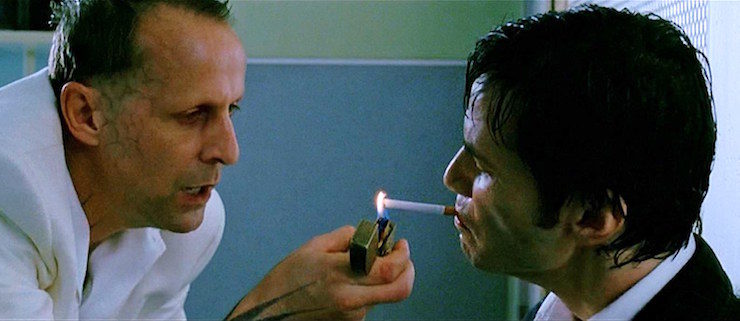
So he slits his wrist. He knows that he’s not only destined for hell, but that Lucifer himself will show up to claim his soul—which indeed he does. Constantine then tells Lucifer about how Mammon and Gabriel have teamed up to mess up the bargain he and God made. Lucifer isn’t thrilled, and he casts Mammon out of Angela and sends sonny boy back to hell. He also remonstrates with Gabriel, who is unable to harm Lucifer, having apparently also pissed God off.
In exchange for this service, Constantine doesn’t ask for anything for himself, instead that Isabel be allowed to go to heaven, since her suicide was in service of humanity. Lucifer agrees—but then he is unable to claim Constantine’s soul, because the sacrifice he made is also worthy of heaven.
Pissed off, Lucifer reaches into Constantine’s chest and removes the cancer from his lungs. Now he won’t die, and Lucifer is quite convinced that Constantine will earn his way back to hell soon enough. Gabriel is now human, wings burned away, and tries to convince Constantine to finish him off, but Constantine instead socks the angel right in the jaw so he feels pain for once.
Constantine gives the Spear of Destiny to Angela to put away somewhere safe where Constantine doesn’t even know where it is. They go their separate ways, though each expresses an interest in seeing each other again. Constantine pops some nicotine gum.
“You’re fucked”
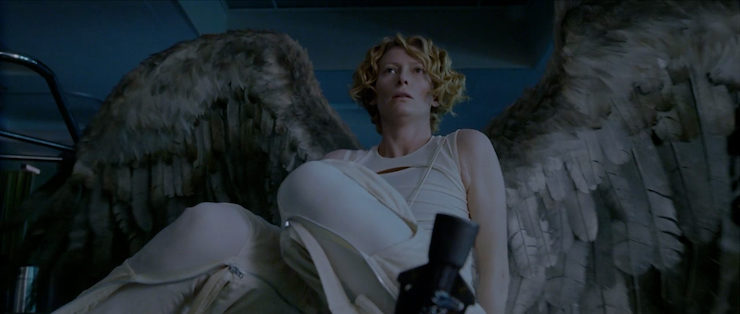
Three years ago on this very web site, Leah Schnelbach wrote a very good piece on why this movie is a terrible adaptation of Hellblazer but actually quite a good movie. Which is annoying because Leah basically stole my thunder, as that’s what I was gonna say, dagnabbit!
This is actually quite an impressive little horror movie. It makes good use of Christian mythology, has a couple of clever twists at the end, and is a visual feast. Francis Lawrence and his director of photography Philippe Rousselot do an amazing job here, as the movie is a fantastic spectacle. Everything works, from the stellar trapping-the-demon-in-the-mirror sequence early on, to hell looking like an atom bomb going off constantly, to Angela being yanked through numerous walls and offices, to Peter Stormare’s white outfit and tar-dripping bare feet as Lucifer, to the demon who attacks Constantine on the street. Motifs of water and broken glass recur throughout, and it makes for a strong cinematographic experience.
Unfortunately, Lawrence is missing out on one very important element of John Constantine, and it’s one that’s entirely on him, because looking back on it, the script got this right: humor. Constantine is a magnificent smartass and the movie should be full of laughs. And if you look at the dialogue, the movie could have gone that route. But while Lawrence did an amazing job of creating the visuals of this particular interpretation, his directing of the actors didn’t quite cohere.
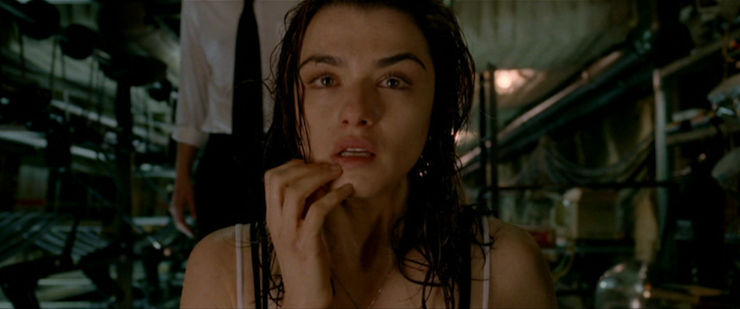
The casting is often blamed for why this movie failed, and it’s a fair statement. Keanu Reeves is playing an interesting protagonist, but it’s not John Constantine. This is a character with a very distinctive voice and mode of operation, and this movie only has a tiny portion of it. It’s not just that, though. Other adaptations have done the same, but usually it’s done in the service of making the character more compelling or because the story demands it. Here, though, all Lawrence and Reeves do is make Constantine more boring. He’s yet another square-jawed cynic out of the Clint Eastwood school of stone faces, and it’s just not that interesting. (Reeves will do better with this particular type of hero nine years hence in John Wick. In fact, this feels a lot like his audition for that role, especially his meticulous rapid-fire shooting of the demons in the hospital after he sprays them with holy water.)
Having said that, Reeves does play Constantine’s frustration and fatalism very well. As played by Reeves, Constantine is the type of hero I’ve always found most interesting: the one who has every reason to give up, to throw in the towel, but he antes up and kicks in no matter what. They also avoid the romance trap, though in an amusing way. Twice it looks like Constantine is going to kiss Angela, and both times she expects it, and in each case Constantine is actually doing something different (putting a charm around her neck, retrieving the Spear of Destiny).
But it’s frustrating, because the script is actually a pretty good Hellblazer story. In fact, it’s an adaptation of a Hellblazer story, specifically the “Dangerous Habits” arc from issues #41-46 of the comic in 1991, by Garth Ennis & Will Simpson. I actually like some elements of the movie’s adaptation better than the original, particularly the ending. I found Lucifer curing him to keep him from going to heaven to be much more satisfying than Constantine’s rather unconvincing tricking of two other lords of hell in the original comic.
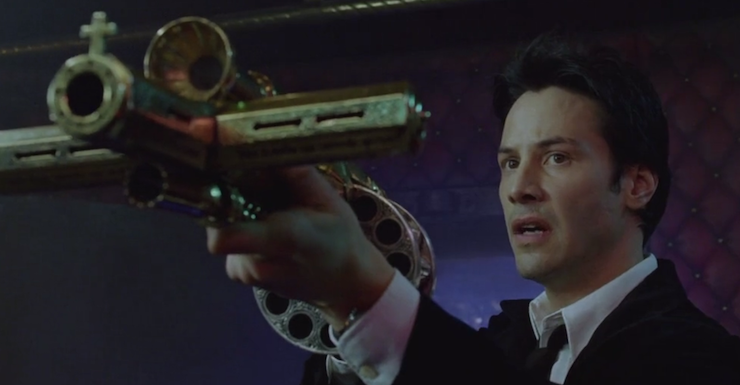
Some of this may be the result of this being Lawrence’s first feature film, as the acting is hit-and-miss. Reeves, we’ve already covered. Shia LeBoeuf is completely nowhere as Kramer, though one doesn’t always have the highest expectations for LeBoeuf. Rachel Weisz is uncharacteristically bland as the Dodson twins, Djimon Honsou is a bit too subdued as Midnite (there’s one moment when he gives Kramer and Constantine a broad smile right after he agrees to help him, and we needed more of that and less of the dour bar owner), and the script underserves Pruitt Taylor Vince, who does the best he can with Hennessy.
The film is made, however, by Stormare and Tilda Swinton. The latter is simply transcendent as Gabriel, and Stormare pretty much steals the entire movie when he shows up, feet dripping with tar, as Lucifer.
In the end, this could have been a good adaptation of Hellblazer, but it failed. It is a great horror noir picture, at least, and it’s simply gorgeous to look at, so it should be viewed that way. It might be hard to pretend it’s some other guy who happens to be named John Constantine—especially since it’s an adaptation of one of the character’s most popular story arcs—but if you can, you can just sit back and enjoy it that way.
Next week, we look at another 2005 horror comic adaptation, Man-Thing.
Keith R.A. DeCandido also reviewed Mary Shelley for this site earlier this week. He also urges folks to support his Patreon, which will include reviews of Deadpool 2, Solo, Black Lightning, and more over the course of the next week.










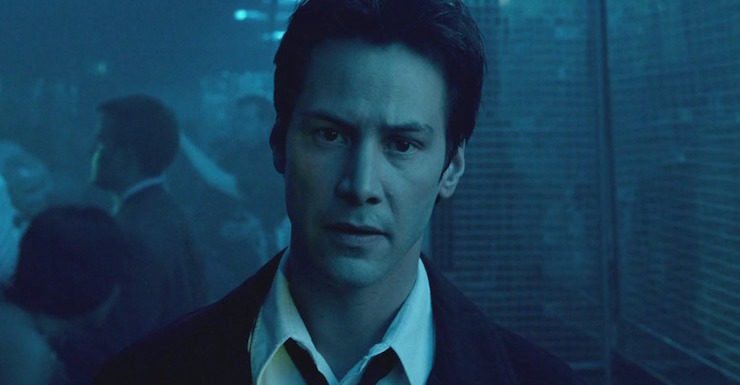
Agreed with everything, Keith! It’s actually one my favorite movies.
When you write “Welsh, in truth,” do you mean “yeah, really that British,” or are you one of those Tor columnists who think “British” is another word for “English,” so Welsh is not really that British?
del: trying to thread the needle between “from the British Isles” and not just assuming everyone from those islands is the same nationality. :)
Also — and I’ll get into this more when I get to Batman Begins — I’m starting to realize why the first Nolan Bat-film is so much more beloved by people other than me. Look at what else came out superhero-wise in 2005: this, Catwoman, Elektra, Son of the Mask, The Crow: Wicked Prayer, and Man-Thing. By comparison, Batman Begins is Citizen Kane………
—Keith R.A. DeCandido
I knew you thought this was a good movie, krad, but I will have to disagree (we’ve done so in the past, but we rarely do). The adaptation is shit, and the movie wasn’t good either if it had been an original work. I despise this film.
The worst offense, after making Constantine American and taking him away from London, was having John chew on nicotine gum at the end, instead of just lighting up another cigarrette.
The holy water sprinkler scene was a bright spot, though. And your review makes the movie sound a lot better than it actually was.
I did not, however, remember that Gabriel was Tilda Swinton. I didn’t even remember the role being played by a woman.
krad: That, and the fact that the last time we saw Batman he was slinging around a Bat-credit card and popping Bat-skates from his boots. Nolan would’ve needed a frontal lobotomy to lower the bar any further…
@3/krad: Interesting observation about Batman Begins being well-regarded because its competition was so poor. That’s sort of the inverse of my view on the Green Lantern feature film — that it wasn’t actually bad, it just had the misfortune to come out in the same year as Thor, Captain America: The First Avenger, and X-Men: First Class. If it had come out before 2008, it would’ve probably been considered a pretty good superhero movie.
I agree with you, Chris. Green Lantern was pretty good for the time, but it had some serious competition.
I remember when the film was new, fans also complained that the characters mispronounced “Constantine”.
I usually take points off a film if it’s about a random magical artifact, especially if it’s a jewel or a cut and thrust weapon. And I was disappointed that instead of Kit Ryan, the female lead was the rather bland Angela Dodson. Still, I kinda liked the film. Lucifer, Gabriel and Midnite were all more interesting than their comic book counterparts, and I liked that Constantine had a problem to solve that wasn’t just about himself.
Re: Matt Ryan being Welsh. He is!
He’s also British.
Wales [Cymru in Welsh] is a separate country with its own parliament since 1987. But it is also part of the kingdom of Great Britain since 1707.
It has had its own kings in the past and has a kickass flag featuring a red dragon.
**
(I guess it’s a bit like America gaining Hawaii as one of the states).
I love this movie. It’s one that I will always stop on when it pops up on cable. I realize not having to care about how close things are to the comics has a lot to do with it. On its own it’s a fun movie so the comics don’t matter.
I don’t remember that much of Constantine, but I was mostly okay with it. It wasn’t a very good adaptation, I thought, but then I’m hardly an expert on Hellblazer comics either. On itself the movie was on the bland site but not that terrible.
Green Lantern I kinda actually liked. Ryan Reynolds was a little all over as Hal Jordan, being more like a weird mashup of Hal with traits from Guy and Kyle, but then again that wasn’t much of a loss to me since Hal’s always been my least favorite GL.
Next week should be interesting, since I’ve never watched Man-Thing myself.
I’ll be getting to Green Lantern around the end of November, based on the current schedule.
—Keith R.A. DeCandido
@9/philippa: I don’t think Keith meant to imply that Welsh isn’t British; he was just specifying which specific flavor of British Matt Ryan is. Which is relevant because it’s different from John Constantine’s variety of Britishness, which is English, specifically Liverpudlian. So Ryan is a closer match to the character than Keanu Reeves, certainly, but not an exact match. But at least, unlike Reeves, he’s able to fake a Liverpool accent reasonably convincingly. (Well, convincingly enough for American ears, at least.)
Typo alert: it’s Stormare.
I also think this movie was underrated, and I think it was a decent adaptation (though I kept waiting and waiting for Elly to show up :sad:). I don’t even mind it being transplanted to LA, as that fits with the noir detective feel.
Buuuuut I do feel like they stripped out the class struggle that was very important in the early runs of Hellblazer. I mean yes technically Mammon and Gabriel are the antagonists, but you could have substituted any other demon and angel really. Contrast this with the Snob from the comics, where even his name tells you everthing you need to know.
I also think they made Constantine take a little too much direct action instead of being more trickster. But maybe this can be blamed on having to Hollywood-up the movie.
@14: Fixed, thanks!
I haven’t actually seen this movie, but it sounds like something I might like. I haven’t read any of the comics, but I did enjoy what I saw of the TV show and was a little disappointed when it didn’t get picked up for another season.
When I first saw this movie, I didn’t even know it was a comic book adaptation, which is probably for the best. Without something to compare it to, it’s a pretty good flick.
@9 Some historical mistakes there.
Wales never had Kings. It had Princes, which was essentially the same thing. After the death of Llwellyn the Last, the final Welsh prince, the title of Prince of Wales became a role for the heir to the English throne, to prepare them for the big job.
1707 is the date of the Act of Union between England and Scotland, forming the United Kingdom. Unlike Scotland, Wales didn’t have its own parliament or clearly recognised borders, but the legislative union with England was pushed through under Henry VIII, some 150 years previously.
I loved this movie when it came out, and I still do. We watched it again last October. LeBeouf was the only one I had issue with, and that was probably more down to him being the obnoxious sidekick than anything else. I agree with the OP that Swinton and Stormare are amazing to watch. They are definitely my favorite part, but I do like Reeves, regardless.
As for source, I had never read Hellblazer beforehand. Probably like most. I attempted a one shot later and disliked it. I’ve also hated everything I’ve read that was by Moore.
We also tried watching the series when it came out and though I thought the actor was trying his best…it was well and truly awful. We only got a few episodes in. I was outright laughing at things I shouldn’t have and there were many nonsensical character decisions/plot holes. I feel like some actors were told to go camp, and others told to be serious. I’m fine with either way, but not both in the same set.
The scene that made the movie for me was when Peter Stormare started dragging Keanu Reeves away and then found that he … couldn’t. That effect/reveal was perfect.
philippa @9, it’s not like Hawaiians being American, it’s like Native Americans being American.
Chris: Ryan doesn’t really do a Liverpudlian accent, as he says himself (he calls it “well-traveled”, with touches of this-and-that, including Ryan’s native Welsh)
That said, I’m the lone soul on earth who thinks they’re still miles away from Constantine (continuing to mispronounce his name, as alluded to upthread, doesn’t help) with Ryan–both the writers and Ryan himself. Admittedly, trying to stuff a character like John into an NBC or CW series isn’t a great idea in the first place (and precludes a lot of what makes him who he is), but on a more “subtle” level, I get a lot of wiry, persistent energy out of Ryan’s performance, which is never how John struck me–seemingly archetypal “laconic with a dry wit”, and lots and lots of deadpan. That and his tendency to completely ruin the lives of people around him, even if he doesn’t get them killed immediately (like Chas)
(but then, I’m also biggest on him as written by Delano, so what do I know…)
@23/FangsFirst: Well, the NBC Constantine did repeatedly explore how Constantine ruined things for his friends and allies, or got them killed. It had to strike a balance between acknowledging what a piece of work he was and making him a relatively more heroic figure to suit the needs of American TV. They basically did that by having him learn that he had a chance to earn his way out of damnation by doing enough good works.
So far, Legends of Tomorrow has given us a more comical version of Constantine and hasn’t really delved into his toxic effect on those around him. But it’s worth noting that both of the other series regulars from his own show are nowhere to be seen now, and Constantine has recommitted himself to working alone. So that implies that things didn’t work out so well for Chas and Zed, or at least his relationships with them.
@22 – del: Actually, it’s pretty much like Hawaiians being American, because Hawaii was an independent country that was annexed by the US in 1898.
Wales was Britain first and always. Hawaii wasn’t America until inducted in.
That’s right, but once more, krad was not saying that Wales is not British, but rather that Ryan is British and specifically Welsh.
@26/del: I think what you mean to say is that Wales was part of the entity called “Great Britain” from its founding in 1707, rather than a territory added later like Ireland, or like Hawai’i to the US. But of course, if you go back far enough, Wales was an independent culture that was conquered by England and only gradually became fully integrated with it.
@28/ChristopherLBennett – yeah, not to belabour the point, but “he’s a Brit, specifically Welsh” is the same as “he’s American, more specifically Virginian.”
However, can you explain what you mean by Wales and England being “integrated”? I’m not sure that describes how the Welsh feel.
Under the article written by Leah SchnelBach, I’ve written how much I enjoyed this movie and at length how much I liked the hate-healing scene with Lucifer. :).
@29/WillMayBeWise: I mean political integration, whether a region is treated as a separate country or as a part of a larger country. Wales existed as an independent country until it was conquered by England in the late 1200s. After that it was treated as a royal fief, a conquered territory owned by the crown and endowed to the heir to the throne (which is where the title “Prince of Wales” came from). But finally, in 1535, Wales was fully incorporated into the Kingdom of England, with England and Wales being treated as a single political and legal entity rather than a state and its fiefdom. Then in 1707 the Kingdom of England (including Wales) merged with the Kingdom of Scotland and became the Kingdom of Great Britain, and then in 1801 it became the United Kingdom of Great Britain and Ireland, and now it’s the United Kingdom of Great Britain and Northern Ireland in the wake of the Republic of Ireland regaining its independence.
https://en.wikipedia.org/wiki/History_of_the_formation_of_the_United_Kingdom
Surely this film stands foremost as a good Keanu Reeves movie though? I mean I know that as far as a faithful comic book adaptation of the source material it’s a joke but it does make a point that Keanu Reeves does make at least 1 great movie choice every 5 to 10 years. Also, I was surprised that the Matrix wasn’t included on this list since it is as close to a comic book movie you can get without it being a comic book, ha.
Also good to hear some mention of the cancelled before its time TV show as well, I mean that wasn’t really faithful to the source material either but I liked it.
Oh btw, Tilda Swinton can do no wrong.
This rewatch is specifically for live action movies based on superhero comics. The Matrix doesn’t qualify.
—Keith R.A. DeCandido
I finally watched this movie tonight, since it vanishes from Netflix streaming after today, so I figured this was my last chance so I might as well. And I’m glad I did. I can’t say I was impressed by Reeves or LaBeouf, but the film as a whole is most impressive, a really clever, imaginative, stylish, and visually stunning movie with an effective story. I have no basis for comparison other than the TV and animated versions of Constantine, so aside from occasionally imagining Matt Ryan in the lead in place of Reeves, I was pretty much viewing it as its own distinct thing rather than an adaptation, and I agree that it does work very well as a movie in its own right.
I particularly liked the part where John got the half-demon Balthazar to talk by threatening to forgive his sins and send him to Heaven. That was funny.
I’m pretty sure this was the first time I’ve heard Rachel Weisz doing an American accent. She was pretty convincing. And I didn’t find her bland; I felt her strong presence and intensity helped to compensate for Reeves’s blandness.
I must be one of the only fans of Hellblazer that not only really bloody loves this film but who also thinks it’s a very good adaptation.
I think Reeves is fantastic as the darker side of John, all nihilistic and bitter, spluttering up blood as he is dying from heart disease, pissed off that god won’t forgive him for committing suicide when he was FIFTEEN.
I think the film is excellent, great characters, good effects and setting, some interesting character work, the style choices for the characters is inspired.
A really bloody good dark supernatural horror noir.
What makes this a superb movie, is the quality of actors & the special effects. quality of actors & the special effects. Another under rated master piece like Blade Runner, that will only appreciate with time, like a bottle of wine.
My rule of thumb is that, when Rachel Weisz gets to speak in her own accent, she’s one of the best actresses out there; when she has to put on a fake American accent, he performance becomes flat. That said, I really liked this movie. The image of John Constantine giving Lucifer the finger as he ascends into Heaven lives rent-free in my mind.
This is Frank Cappello, the writer that wrote the 2005 Constantine AND ‘a’ Constantine 2 for Keanu back in 2011. You want to know more about how the film got started, the inside scoop of being a writer in the studio system, the politics that can a make or break a project – I think you’ll like this mini doc “How I wrote Constantine A Journey to Hell and Back.”
https://www.youtube.com/watch?v=Nzr022EijvQ
Thanks for sharing, Frank!
—Keith R.A. DeCandido